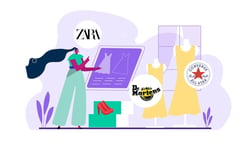If you feel like it might be time to move on from Depop, or just want to try something new, there are a lot of other platforms worth selling on. Whether you’re after lower fees, a different audience, or just more sales, this post breaks down some of the best Depop alternatives to help you figure out your next move.
Best Depop Alternatives in 2025
Poshmark
Best for fashion sellers who want a social, beginner-friendly selling experience.
Cost: Free to list. 20% seller fee on sales over $15 and a $2.95 flat fee on sales under $15
Pros
Easy to List: Listing on Poshmark is pretty easy and super beginner-friendly.
Flat Buyer-Paid Shipping: You don’t have to weigh your item (if it’s under 5lbs) or calculate shipping. Poshmark charges the buyer a flat shipping fee and provides you with a label.
Popular Marketplace: With millions of users, your items will have a huge audience.
Marketing Tools to Help Sales: Built-in features like bundle discounts, offers to likers, price drops, closet cleanouts, and more can really help boost visibility (and sales!)
Cons
High Commission Fees: 20% is higher than most other marketplaces.
Daily Sharing: To stay visible, you need to share regularly. Tools like Vendoo can help automate that so you don’t have to do it manually.
Shipping Costs: While flat-rate shipping is convenient, it can make buyers hesitant for low-cost or lightweight items.
Want to learn about selling on Poshmark? How to Sell on Poshmark: A Step-by-Step Guide to Success
Vinted
Best for casual sellers who want to avoid seller fees and sell secondhand clothing.
Cost: Free to sellers. Buyers pay a service fee.
Pros
No Seller Fees: On Vinted, buyers pay a service fee while sellers pay no fees and keep 100% of the sale.
Simple Listing Process: Uploading new items is quick and easy via app or desktop.
Provided Shipping Labels: Buyer pays for shipping, and Vinted sends you the label, simplifying the whole shipping process.
Cons
Buyer-Paid Service Fee: Buyers may hesitate when they see the extra cost added at checkout.
Limited Reach: Vinted is still growing in the US, so there aren’t as many buyers compared to more popular marketplaces.
Slower Sales: Fewer buyers and a more budget-focused audience can lead to longer sell times.
Commercial Selling Prohibited: Vinted policies state that you can’t sell in bulk or operate as a business seller.
Looking to scale your reselling business? Explore our Top Rated Online Marketplaces
Vestiaire Collective
Best for selling authenticated luxury, designer, and high-end fashion items to an international audience.
Cost: Listing is free. 10% selling fee ($10 minimum) + 3% payment processing fee.
Pros
Trusted Platform for High Value Goods: Ideal for selling luxury, designer, and authenticated items.
International Luxury Shoppers: Access to buyers around the world looking for high-end items.
Professional Presentation: Listings are clean and professional, with authentication options, which build buyer trust.
Cons
High Minimum Commission Fee: Although the 10% fee is similar to Depop, there is a $10 minimum fee, which is high for lower-priced items.
Longer Selling Times: Buyers for luxury items are more selective, so it may take longer to sell.
Less Suitable for Everyday Items: Not the right platform for common, lower-priced items.
eBay
Best for sellers who want to reach a global audience and list a wide variety of items beyond fashion.
Cost: Free to list up to 250 items/month. Final value fee averages 13%-15%, depending on category.
Pros
Massive Global Audience: Ebay is easily one of the largest marketplaces in the world.
Trusted Brand: Most people have heard of eBay, making it a more trustworthy platform.
Wide Variety of Products: You can sell almost anything on eBay and aren’t restricted to just clothes and accessories.
Built-in Marketing Tools: Ebay has marketing and promotional tools like promoted listings, markdown sales, sending offers, etc. to help you make a sale.
Cons
Complicated Fee Structure: Fees vary based on category and sale price, which can be confusing.
Price Driven Competition: Lots of competition, which can lead to lowering prices to stay competitive.
Order Disputes: When disputes come up, it can take time to resolve. Your money is usually held during this time.
Shipping Learning Curve: If you’ve never shipped items before, having total flexibility over shipping can feel overwhelming.
Interested in selling on eBay? How to Sell on eBay: A Guide for Beginners
Mercari
Best for general sellers who want low fees, simple listings, and flexible shipping options.
Cost: Free to list. 10% selling fee.
Pros
Wide Variety of Categories: If you sell more than just clothes, Mercari has a lot of categories you can choose from.
Simple Listing Process: The Listing form is relatively short and easy to fill out.
Variety of Shipping Options: Choose from a Mercari-generated label or ship on your own.
Lower Fees: The 10% fee is the same as Depop’s, which is on the lower end compared to other marketplaces.
Cons
Less Specialized Audience: Mercari doesn’t have the same fashion-focused community as Depop or Poshmark.
Budget Focused Audience: Many Mercari users are looking for deals, and you may need to accept offers to make sales.
Learn more about selling on Mercari in this Mercari Review for Resellers.
Grailed
Best for sellers of luxury menswear and streetwear.
Cost: Free to list. 9% commission fee + payment processing fee for 3.49% + $.49.
Pros
Specializes in Luxury Menswear: Great for streetwear, designer labels, and limited edition men’s fashion. If this is your niche, it’s definitely worth selling on.
Fashion-Savvy Community: Grailed attracts buyers who are knowledgeable and passionate about fashion.
Generous Photo Limit: You can upload up to 25 photos per listing, which helps show details of your item.
Cons
Menswear Focused: Not ideal if you primarily sell women’s or children’s items.
Can’t Sell Multiple Quantities: There’s no way to create a listing with multiple quantities.
Fashion Only: Grailed strictly permits only fashion-related listings, excluding other categories.
Etsy
Best for sellers of true vintage items (20+ years old) who want to build a brand.
Cost: $.20 fee per listing. 6.5% transaction fee.
Pros
Best to Build a Brand: Etsy supports branding through store customization.
Strong Community & Reputation: Etsy has a loyal customer base that actively seeks out unique, handmade, and vintage items.
Good for Vintage Sellers: Etsy is one of the best platforms for selling true vintage (20+ years old) items.
Effective Promotional Features: Etsy Ads and coupons can help increase sales.
Cons
Not for Trendy or Modern Goods: Etsy only allows handmade items, vintage pieces (20+ years old), or craft supplies. Modern, factory-made products aren’t permitted.
Listing Fee Regardless of Sale: Your listing auto-renews every 4 months, which can add up if items don’t sell.
The Truth? Selling on Multiple Marketplaces is the Answer
If you’ve outgrown Depop, are frustrated by slow sales, or want to reach more buyers, exploring alternative platforms is a smart move. But here’s the truth: you don’t have to choose just one.
Vendoo makes it easy to crosslist your inventory from Depop to marketplaces like Poshmark, eBay, Mercari, Vinted, Grailed, and Etsy.
👉 Sign up for Vendoo to start crosslisting today and see what happens when your items are everywhere your buyers are.







